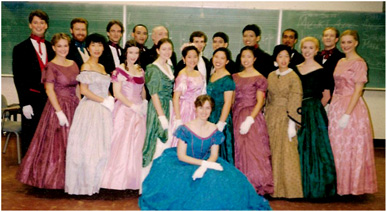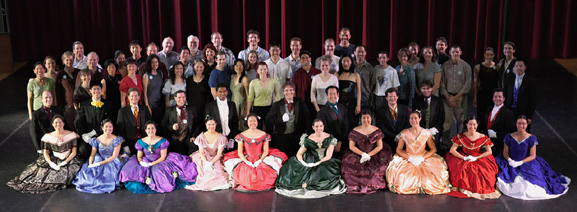|
Make your event memorable.
We would be delighted to perform at your event. We perform
at a variety of balls, festivals, private, corporate, and
community events, mostly in the San Francisco Bay area. Our
season extends from October to June, and during the summer
on prior arrangement. Performance times can range from minutes
to an hour, and can exhibit several eras or focus on a particular
time, depending on the occasion. Please e-mail our directors
(Jeremy and Lily) at

for more information on performance scheduling and fees, or
mail us at:
Academy of Danse Libre
PO Box 1166
Mountain View, CA 94042-1166
Like to dance?
If you have a passion for dance, costuming, or period history—or all three!—come join us! We hold auditions every fall. See our auditions page for details.

In 1996 a group of 24 intrepid dancers, many
of whom were alumni of Stanford's Vintage Dance Ensemble,
formed a new performance group. Led by James Mendoza and Kristina
Ho, they selected the name “The Academy of Danse Libre” in the
spirit of a quadrille choreographed by students in the Latin
Quarter of Paris in the 1840s. With liberated spirits, these
students took the intricate steps that they had learned as
children in dancing school and “exploded” them
into bounds, kicks, and extravagant capers. In 1996, these enthusiastic Stanford-affiliated
dancers sought to create a vivid picture of the mayhem and
joyful passion of the lively dance halls from days gone by.
In rehearsals at Bethany Lutheran Church, breathtaking choreographies
from the 19th and early 20th centuries were carefully choreographed.
The new group performed nine times in its first season at
venues ranging from Stanford University, to the International
Folk Dance Festival in Southeast Los Angeles, to the Mid-Peninsula
Widows and Widowers Club.
As the years passed, the group expanded its
repertoire. New choreographies were developed both by group
members and by group affiliates such as dance historian Richard
Powers. In the spring of 1999 Danse Libre held its first biennial
Spring Show, titled "Brahms in
Motion." Danse Libre's largest performance in its young
history, the dance concert featured 20 choreographies from
the Victorian and Regency eras. In succeeding years, the danseurs
began to study Ragtime pieces as well as dances from the 1920s
and 1930s. Choreographies for each of these periods were—and
continue to be—designed to represent the historical
traditions as well as to be lighthearted and playful. The
Waltz Cotillion is reminiscent of the social mixers held in
bygone eras. The German dallies with role reversal, with the
women coyly blindfolding the men and taking the lead. The
Samba, or Africanized polka, is a traditional party dance
of the 1920s. And the Parisian Tango—nicknamed the
"Comic Tango" by many—demonstrates the tenuous
balance between group cohesion and individualism in the performance
of choreography.
Today Danse Libre has expanded from a dance
group into a dance community, with a network of alumni stretching
across the Bay Area and the nation. In its fifteenth season,
Danse Libre continues to captivate audiences across the peninsula
and the state. Off of the stage, the danseurs frequent an
array of informal dance venues, from Friday
Night Waltz, to Swing
Central/Rhythm Lounge and Wednesday
Night Hop, to Jammix
at Stanford. Experimentation while social dancing infuses
traditional choreographies with the energy of new variations
and inspires the genesis of new pieces.

|
